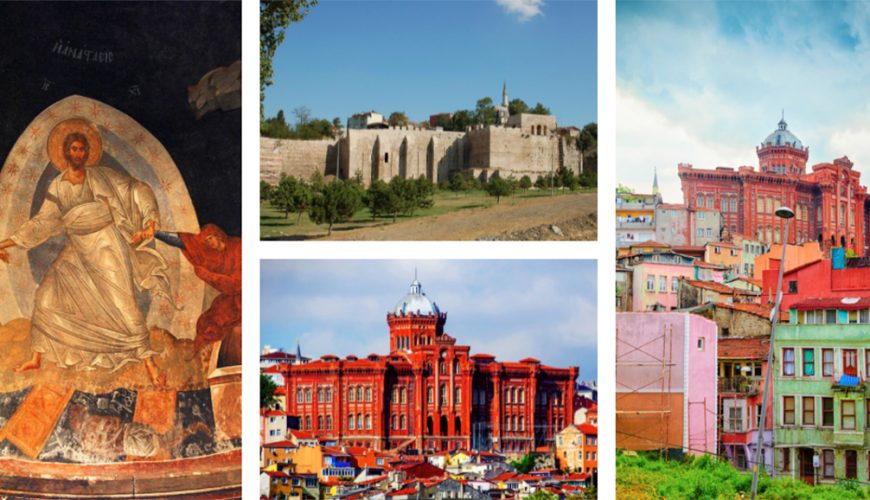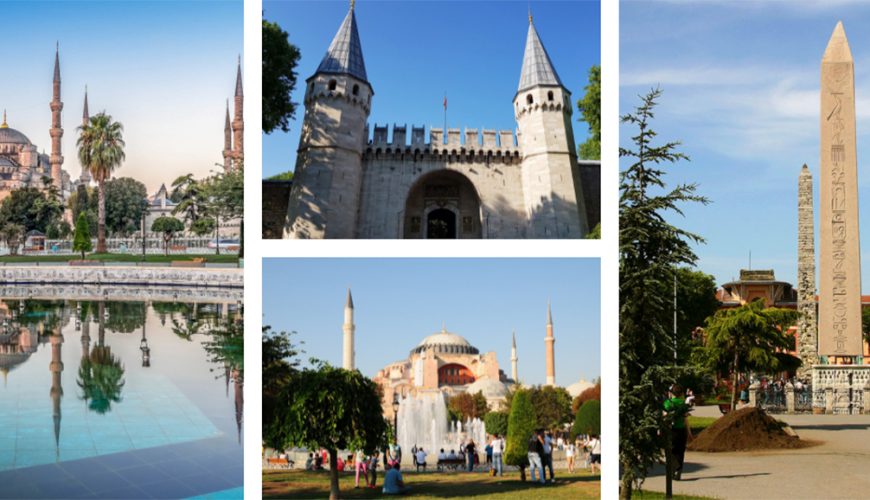Category: Questions about Istanbul
- Home
- Category: Questions about Istanbul
The Basilica Cistern was constructed during the reign of Justinian I (527-565) to serve the palaces around it. There are 336 columns in twelve rows of 28. The cistern is 140 meters long by 70 meters wide, with Corinthian capitals on top that range from simple to elaborate. Water levels in the reservoir fluctuate according […]
Read More
The Basilica Cistern was constructed during the reign of Justinian I (527-565) to serve the palaces around it. There are 336 columns in twelve rows of 28. The cistern is 140 meters long by 70 meters wide, with Corinthian capitals on top that range from simple to elaborate. Water levels in the reservoir fluctuate according […]
Read More
The Basilica Cistern was constructed during the reign of Justinian I (527-565) to serve the palaces around it. There are 336 columns in twelve rows of 28. The cistern is 140 meters long by 70 meters wide, with Corinthian capitals on top that range from simple to elaborate. Water levels in the reservoir fluctuate according […]
Read More
The Basilica Cistern was constructed during the reign of Justinian I (527-565) to serve the palaces around it. There are 336 columns in twelve rows of 28. The cistern is 140 meters long by 70 meters wide, with Corinthian capitals on top that range from simple to elaborate. Water levels in the reservoir fluctuate according […]
Read More
The Basilica Cistern was constructed during the reign of Justinian I (527-565) to serve the palaces around it. There are 336 columns in twelve rows of 28. The cistern is 140 meters long by 70 meters wide, with Corinthian capitals on top that range from simple to elaborate. Water levels in the reservoir fluctuate according […]
Read More
The Basilica Cistern was constructed during the reign of Justinian I (527-565) to serve the palaces around it. There are 336 columns in twelve rows of 28. The cistern is 140 meters long by 70 meters wide, with Corinthian capitals on top that range from simple to elaborate. Water levels in the reservoir fluctuate according […]
Read More
The first Chora Church was rebuilt by Justinianus (527-565) in place of this chapel. However, it was destroyed during Latin invasion (1204-1261). In 1328, Andronikos II repaired it due to admiration for its architecture and history as he had seen it while on a pilgrimage to Jerusalem. The Chora Church’s mosaics and frescoes are some […]
Read More
The first Chora Church was rebuilt by Justinianus (527-565) in place of this chapel. However, it was destroyed during Latin invasion (1204-1261). In 1328, Andronikos II repaired it due to admiration for its architecture and history as he had seen it while on a pilgrimage to Jerusalem. The Chora Church’s mosaics and frescoes are some […]
Read More
The first Chora Church was rebuilt by Justinianus (527-565) in place of this chapel. However, it was destroyed during Latin invasion (1204-1261). In 1328, Andronikos II repaired it due to admiration for its architecture and history as he had seen it while on a pilgrimage to Jerusalem. The Chora Church’s mosaics and frescoes are some […]
Read More
The first Chora Church was rebuilt by Justinianus (527-565) in place of this chapel. However, it was destroyed during Latin invasion (1204-1261). In 1328, Andronikos II repaired it due to admiration for its architecture and history as he had seen it while on a pilgrimage to Jerusalem. The Chora Church’s mosaics and frescoes are some […]
Read More
Until the middle of the 19th century, Topkapi Palace served as the Ottoman sultans’ and their court’s home. Sultan Mehmed II, the conqueror of Constantinople, built the palace between 1460 and 1478 and added to it numerous times throughout its long history. The palace was not only a residence for Ottoman rulers, but also an […]
Read More
Until the middle of the 19th century, Topkapi Palace served as the Ottoman sultans’ and their court’s home. Sultan Mehmed II, the conqueror of Constantinople, built the palace between 1460 and 1478 and added to it numerous times throughout its long history. The palace was not only a residence for Ottoman rulers, but also an […]
Read More
Until the middle of the 19th century, Topkapi Palace served as the Ottoman sultans’ and their court’s home. Sultan Mehmed II, the conqueror of Constantinople, built the palace between 1460 and 1478 and added to it numerous times throughout its long history. The palace was not only a residence for Ottoman rulers, but also an […]
Read More
Until the middle of the 19th century, Topkapi Palace served as the Ottoman sultans’ and their court’s home. Sultan Mehmed II, the conqueror of Constantinople, built the palace between 1460 and 1478 and added to it numerous times throughout its long history. The palace was not only a residence for Ottoman rulers, but also an […]
Read More
Until the middle of the 19th century, Topkapi Palace served as the Ottoman sultans’ and their court’s home. Sultan Mehmed II, the conqueror of Constantinople, built the palace between 1460 and 1478 and added to it numerous times throughout its long history. The palace was not only a residence for Ottoman rulers, but also an […]
Read More
Until the middle of the 19th century, Topkapi Palace served as the Ottoman sultans’ and their court’s home. Sultan Mehmed II, the conqueror of Constantinople, built the palace between 1460 and 1478 and added to it numerous times throughout its long history. The palace was not only a residence for Ottoman rulers, but also an […]
Read More



